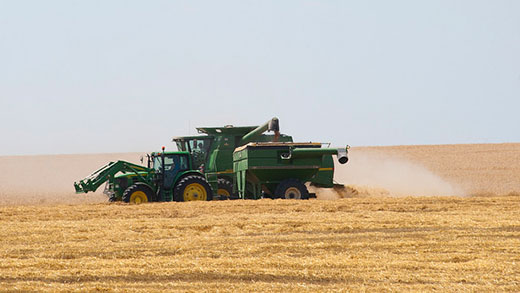
Some farmers are turning to non-traditional lenders to finance their business. (File photo)
K-State’s Ifft says the trend is toward alternate ways of seeking funding
MANHATTAN, Kan. – A Kansas State University agricultural economist says that non-traditional lenders are becoming a bigger part of doing business in farm country.
Jenny Ifft spoke recently at the Risk and Profit Conference, hosted by K-State Research and Extension and the K-State Department of Agricultural Economics. Her talk highlighted a growing trend by farmers to seek alternate ways of funding their business.
“They are an important part of the financial landscape, and as far as we can tell, they are growing,” Ifft said.
The majority of farmers use farm credit lenders and commercial banks to finance purchases of land, equipment, crop insurance or other expenses.
But Ifft notes three categories of lenders that producers are now turning to as alternatives, including:
- High value, branchless lenders. These are mostly life insurance and private lenders who work with larger clients and don’t have local branches. They may know their clients well and may offer great service. Their interest rates are very competitive.
- Vendor finance lenders.Anybody who sells goods to a farmer, sells credit too. Vendors who sell the products extend credit to producers for the cost of the goods. Financing is provided internally or through a third party.
- Collateral-based financing. These are primarily agricultural lenders, but are not deposit-taking lenders. Their decision to provide a loan is primarily based on the value of the collateral, such as equipment or value of a crop. They typically invest in developing a relationship with their clients. Often, the interest rate is higher than traditional loans, especially higher-risk loans.
“Some of these non-traditional lenders have been in business for a long time,” Ifft said. “It’s hard to tell how much producers are using non-traditional lenders because these businesses are not always subject to public reporting of their lending activity.”
For farmers, seeking a non-traditional lender can be a matter of convenience and service, she said.
“That may be especially true with vendor financing,” Ifft said. “They make it pretty easy for people. And a lot of times these aren’t huge loans in the scope of the entire operation. It’s a relatively small loan that is easier to apply for. And some of the collateral-based and high-value lenders, as part of their marketing, also are saying they are going to make it easier on a producer than a bank.”
“Another story I’ve been hearing a lot is that we’re starting to see more of the larger, diverse farms using non-traditional lenders. They don’t have conventional business models, so in some cases, it seems like these non-traditional lenders may have more flexibility to work with these types of operations.”
Some data indicates that younger farmers, or farms that are financially-stressed, are turning to non-traditional lenders.
Ifft, who just recently joined the K-State Department of Agricultural Economics, has studied the issue from a farm policy and a farm management perspective. More information on her presentation, and summaries of all of the sessions at this year’s Risk and Profit conference, is available online.
